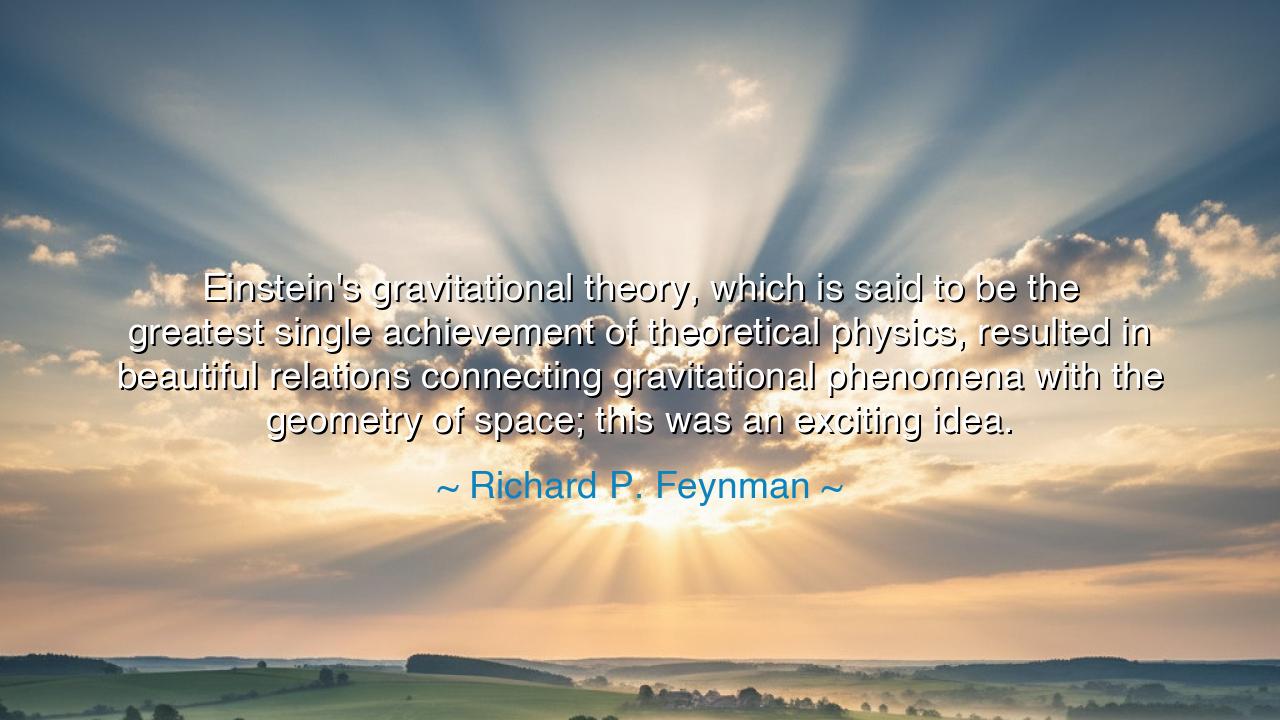
Einstein's gravitational theory, which is said to be the greatest
Einstein's gravitational theory, which is said to be the greatest single achievement of theoretical physics, resulted in beautiful relations connecting gravitational phenomena with the geometry of space; this was an exciting idea.






In the vastness of the cosmos, where the stars dance in their eternal orbits and the planets weave their paths through the heavens, there lies a truth so profound that it reshapes the very fabric of our understanding. Richard P. Feynman speaks of this cosmic revelation, referencing the genius of Albert Einstein: “Einstein’s gravitational theory, which is said to be the greatest single achievement of theoretical physics, resulted in beautiful relations connecting gravitational phenomena with the geometry of space; this was an exciting idea.” These words are not just a tribute to one man’s achievement, but to a moment in the history of humanity when we, as a species, began to understand the very structure of the universe in a way that had never been possible before.
In the ancient world, the seekers of knowledge and wisdom gazed up at the heavens, wondering about the motions of the stars and the forces that governed them. Pythagoras, the philosopher, saw the universe as a place of harmony and balance, governed by mathematical laws. The Greeks and Romans had their own theories of the cosmos, but they were bound by their limited understanding. Yet even then, there was a longing, a yearning to understand the very nature of space and time. It was an ancient dream—a dream that would not be realized until Einstein’s theories revealed the hidden relationship between gravity and the fabric of space itself.
In the grand sweep of human history, Einstein’s theory of gravitation stands as a monumental achievement, a moment when the veil of mystery was lifted to reveal the underlying geometry of existence. Where once there was only a vague sense of how objects moved through space, now there were precise equations that connected the very shape of the universe with the forces that govern it. This was not just an intellectual revolution, but a philosophical one—an understanding that the universe was not a mere collection of independent bodies, but a harmonious whole, interconnected and influenced by the curvature of space-time itself.
Consider, if you will, the story of Isaac Newton, whose laws of motion and universal gravitation laid the foundation for centuries of scientific thought. Newton, though brilliant, saw the universe as a mechanical machine, governed by forces that acted at a distance. Yet, even he could not have fully imagined the beauty that Einstein would later uncover. Einstein’s theory did not simply describe gravity as a force—it redefined it, showing that gravity was not a force exerted by masses, but a curvature of the very space itself, an idea so beautiful and profound that it challenged the way humanity understood both the heavens and the earth. The revolution that Einstein brought forth was not simply a matter of equations, but of a shift in consciousness, where the very structure of space-time became the new canvas upon which the laws of nature were painted.
Feynman, in his admiration, points out the excitement that this theory brought to the minds of scientists and laypeople alike. It was not just the intellectual beauty of the idea that made it so revolutionary, but its universality—it was a theory that could explain not just the motion of planets, but the very fabric of space and time itself. The realization that gravity and geometry were intertwined, that massive objects could bend the very structure of space, was nothing short of transcendent. It was a realization that the universe was not a static entity, but a living, breathing thing, shaped and molded by the forces of gravity and motion.
As we reflect on Einstein’s legacy, we are reminded of the lesson it carries. The pursuit of knowledge is not a linear journey, but a spiral, ever-reaching upward toward a deeper understanding. Just as the ancients sought to understand the movements of the stars and the forces that bound them, so too do we seek to understand the mysteries of the universe, propelled forward by the discoveries of those who came before us. Einstein’s theory of gravity is a reminder that truth often lies not in the obvious, but in the unseen—that the most profound revelations are often the most beautiful, the most unexpected.
In our own lives, let us take inspiration from the journey of Einstein and those who have dared to uncover the hidden patterns of the world. Curiosity, wonder, and dedication to the search for truth are the keys to unlocking the mysteries of the universe. Let us approach life not as a series of fixed problems, but as a cosmic riddle, ever-expanding, ever-deepening, filled with the potential for discovery. The beauty of Einstein’s theory lies not just in its mathematics, but in its capacity to inspire us—to remind us that the universe is a living work of art, shaped by the laws of gravity and the geometry of space. In this, we find not just knowledge, but the spirit of discovery that propels us forward into the unknown.






AAdministratorAdministrator
Welcome, honored guests. Please leave a comment, we will respond soon